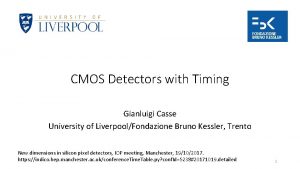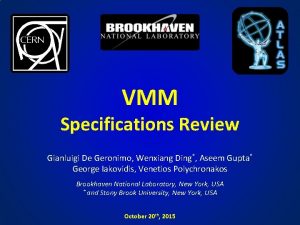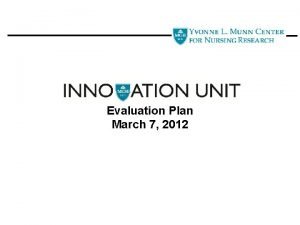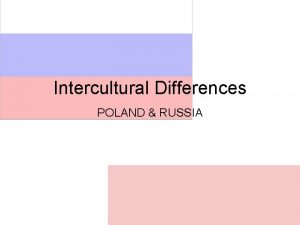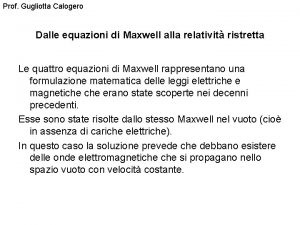ALGOTRADING GIANLUIGI GUGLIOTTA Poland 9 March 2012 DEFINITIONS











- Slides: 11

ALGO-TRADING GIANLUIGI GUGLIOTTA Poland, 9 March 2012

DEFINITIONS • No common agreed definition in economic literature: use of sofisticated tecnology to: ▫ ▫ Define orders parameters (timing, price, quantities, …); Interpret market signals Exploit (guess) the functioning of algorithms used by competitors Quasi-market making • French FTT: Automated trading includes any trading system in which a computer algorithm determines automatically some parameters of the order (algorithms used to “optimize execution conditions” or to route orders towards platforms or used for order confirmation are expressly excluded from this definition) • ESMA Guilines: Trading algorithm means computer software operating on the basis of key parameters set by an investment firm or by a client of an investment firmthat generates orders to be submitted to trading platforms automatically in response to market information • MAR: algorithmic trading means trading of financial instruments using computer algorithms within the meaning [to be set forth by] Mi. FID 2; • Mi. FID 2: Algorithmic trading means trading in financial instruments where a computer algorithm automatically determines individual parameters of orders such as whether to initiate the order, the timing, price or quantity of the order or how to manage the order after its submission, with limited or no human intervention

• BENEFITS • POTENTIAL RISKS • • • Decrease of transaction sizes • Poor quality of liquidity provided • Technological issues: Narrower spreads Better price discovery Increased liquidity Reduced short term volatility Better execution of orders ▫ Overloading of trading system ▫ Duplicative/erroneous orders ▫ Overreacting to market events • Abusive behaviours • Disorderly markets

PROPOSAL FOR A REGULATION ON MARKET ABUSE • Strategies which are likely to consitute market abuse: ▫ The sending of orders to a trading venue by means of algorithmic trading without an intention to trade but for the purpose of: disrupting or delaying the functioning of the trading system of the trading venue; making it more difficult for other persons to identify genuine orders on the trading system of the trading venue; or creating a false or misleading impression about the supply of or demand for a financial instrument; ▫ Quote stuffing: entering large numbers of orders and/or cancellations/updates of orders so as to create uncertainty for other participants, slowing down their process and to camouflage their own strategy; ▫ Layering and Spoofing: submitting multiple orders often away from the touch on one side of the order book with the intention of executing a trade on the other side of the order book (once that trade has taken place, the manipulative orders will be removed); ▫ Momentum ignition: entry of orders or a series of orders intended to start or exacerbate a trend, and to encourage other participants to accelerate or extend the trend in order to create an opportunity to unwind/open a position at a favourable price.

Mi. FID 2 / Mi. FIR INVESTMENT FIRMS • Technological standards: ▫ Resilience and continuity ▫ Trading thresholds/limits ▫ Prevention of unlawfull conducts • Reporting requirements to CA: ▫ Strategies and parameters ▫ Details of key controls ▫ Data stored on orders + TR • Market making obligations: ▫ Continuous operation ▫ Quotation of competitive prices • DEA surveillance responsibilities ▫ Suitability ▫ Respect of thresholds and rules ▫ Risk management TRADING VENUES • Techological standards: ▫ Resilience and continuity ▫ Thresholds limits, trading halts and cancellation ▫ Prevention of disorderly trading ▫ Mere possibility to Limit order to transaction ratio Slow down order flow Limit minimum tick size • DEA surveillance rsponsibilities ▫ DEA limited to authorized firms ▫ Suitability ▫ Responsibility of member firms

Mi. FID 2 EU COMMISSION RESPONSIBILITIES • Delegated acts to armonise in further detail ▫ Organisational requirements on firms performing different investment services of activities ▫ Resilience requirements on trading venues ▫ Trading halts ▫ Ortedr to transaction ratio ▫ Minimum tick size ▫ Controls on DEA ▫ Co-location services and fee structure • Report on the impact of requirements regarding automated and HFT trading (2 yy after entering into force of new provisions)

Borsa Italiana’s fee on desplayed orders (2 -04 -2012) • Scope: desplayed orders exceeding pre-defined order-to-trade ratios ▫ 100: 1 as to equities traded on the main market segment (MTA) ▫ 40: 1 as to equities traded on thei SMEs market (AIM) • Tax Rate: progressive: ▫ ▫ From 1 to 5 times the ratio 0. 01 euro From >5 to =10 times the ratio 0. 02 euro As from >10 0. 025 euro Upper daily threshold 1, 000, 00 euro per market segment (MTA / AIM) • Exemption: market making (specialist)

French FTT on HFT (1 -08 -2012) • Scope: orders cancelled or modified within 1 second (or shorter time limit to be specified by ministerial decree) by an HFT firms trading on own capital and with operations in France where they exceed an order-to-trade ratio to be defined by ministerial decree; • Definition of automated trading: any trading system in which a computer algorithm determines automatically some parameters of the order (algorithms used to “optimize execution conditions” or used to route orders towards platforms or used for order confirmation are expressly excluded from this definition) • Tax Rate: 0, 01% of the value of the cancelled or modified orders • Exemption: market making

PROPOSAL FOR AN FTT DIRECTIVE • Policy goals: … to create appropriate disincentives for transactions that do not enhance the efficiency of financial markets thereby complementing regulatory measures aimied at avoiding future crises • Risk of delocalisation: ▫ Coordinated approach … in line with the ambitions for G 20 co-operation; ▫ Broadly defined tax scope ▫ State of residence (or establishment as for branches) of at least on of the financial actors involved in the transaction (independently from the place of trade of the financial instrument) • Exemptions: ▫ Primary markets (securities and currencies) ▫ Central banks ▫ Ring fencing of lending and borrowing activities

ESMA GUIDELINES ON AUTOMATED TRADING (1 -5 -2012) To promote fair and orderly trading INVESTMENT FIRMS • Block or cancel orders ▫ That do not meet specific parameters ▫ On instruments that traders cannot trade ▫ That compromise the firm’s risk management thresholds ▫ Not consistent with applicable rules • • • Procedures to override autom. blocks Inform authorities: on risks & incidents Rekord keeping Training on order entry procedures Controls: ▫ Real time monitoring procedures ▫ Close scrutiny by compliance staff ▫ Messaging traffic to individual platforms • Manage operational risk • IT compatibility TRADING VENUES • Controls ▫ ▫ Due diligence on non licenced firms IT compatibility Pre and post trade controls Trader access and knowledge • Preventative policing ▫ Cancel, amend or correct transactions ▫ Excessive flooding of the order book ▫ Breaches of capacity limits • • Capacity to constrain or halt trading Obtaining information from members Monitoring Record keeping and cooperation

ESMA GUIDELINES ON AUTOMATED TRADING (1 -5 -2012) To prevent market abuse INVESTMENT FIRMS TRADING VENUES • Understanding, skill and authority of compliance staff • Training in market abuse for traders • Monitoring activities • Identification and reporting of suspicious transactions and orders • Periodic reviews and audit of procedures and arrangements • Record keeping on alert management • Staffing (sufficient and knowledgeable) • Monitoring systems on orders and transactions • Identification and reporting of suspicious transactions and orders • Periodic reviews and audit of procedures and arrangements • Record keeping on alert management
